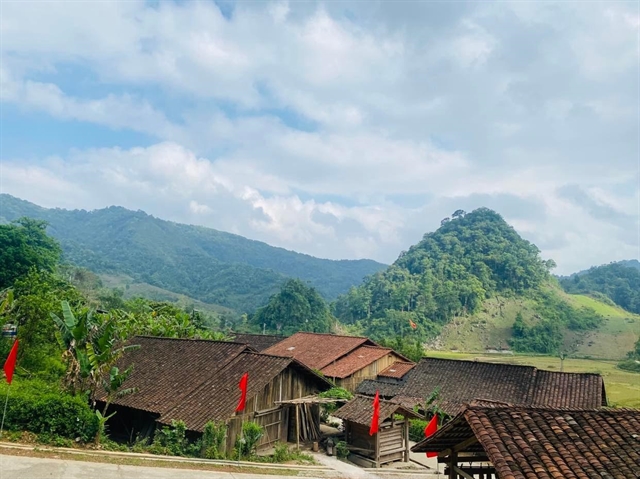May 30, 2022
HANOI – Nestled in a vast valley and surrounded by the majestic Phia Oắc and Phia Đén mountains, Hoài Khao Village in the northern province of Cao Bằng is home to 34 families of the Dao Tiền ethnic community.
A visit to the village offers a rare chance to experience traditional culture and crafts while contemplating the distinctive original architecture that has been preserved for generations.
A village among clouds
It seems that Hoài Khao has not been touched by modernisation. The village has only had electricity for just over two months, though a new concrete road was built several years ago.
Waking up in the morning in a traditional wooden house roofed with the clay tiles of the Dao Tiền and looking out the window, visitors can see spectacular fluffy clouds hanging above ancient cinnamon trees in the garden. In this isolated village, every activity seems to happen in the clouds.

The traditional wooden houses are roofed with clay tiles. Photo anninhthudo.vn
Located 1,000m above sea level and surrounded by primitive forests, the climate is fresh and cool all year round, with some ice in winter, similar to Sa Pa Town in the neighbouring province of Lào Cai.
Living close to nature, the Dao Tiền in Hoài Khao are conscious of preserving the landscape and environment. The primitive forests have protected the village for hundreds of years and still retain many giant ancient trees, proof of the villagers’ closeness to nature.
There is an ancient nhội tree (Bischofia javanica Blume) in the village that is protected and worshipped by locals. It was recognised as a Vietnamese Heritage Tree in September 2020.
The Dao Tiền’s traditional wooden houses are built in the middle of the valley and surrounded by mountains. Below are terraced fields that sparkle under the sunlight, creating picturesque scenery that should not be missed by anyone who enjoys peace and tranquillity.
Taking a walk through the village, visitors can easily catch sight of Dao Tiền women, particularly the elderly, sitting in front of their houses engrossed in embroidering or printing beautiful patterns on fabric with beeswax. They are practising the traditional craft passed down from their ancestors, skillfully creating geometric patterns, plants, flowers, birds and animals with beeswax to make elaborate costumes.

A visitor tries printing patterns on fabric with beeswax. Photo anninhthudo.vn
Those who wish to experience the local life and stay for the night in the village can choose a homestay facility currently offered by seven local households.
“Before being introduced to community-based tourism, the villagers only knew how to make a living by working on the fields and raising livestock. The local life is mostly self-sufficient, so it is difficult,” said Lý Hữu Tăng, the village chief.
“In the past two years, with the support and guidance of the local authorities, people have begun to relocate the barns and converted their houses into homestay facilities.”
Renewal

Hoài Khao Village now has seven homestay facilities to receive guests. Photo baophapluat.vn
However, encouraging Hoài Khao farmers to switch to community-based tourism is not an easy task for local authorities as they have little understanding of the concept.
The local officials had to visit every household and explain the benefits brought about by tourism in detail.
“Hoài Khao has the advantages of beautiful, majestic natural scenery and unique cultural identity, so we should do community-based tourism and offer homestay services to turn the village into a tourist attraction,” said Đào Nguyên Phong, the chairman of Nguyên Bình District’s People’s Committee.
“To provide the locals with experience, they were even invited to visit thriving community-based tourism destinations, like Khuổi Ky Village in nearby Trùng Khánh District.
“After they agreed to pursue tourism, local authorities persuaded them to move the buffalo and pig stables out of their residential areas. Another difficulty is increasing the locals’ awareness and manners. We have to train them how to serve guests and even how to clean their houses and toilets.”
After two years of preparation, in April, Nguyên Bình District officially had seven homestay facilities ready to welcome guests, each with its own features to create various options.
The district’s authorities hold that tourism development needs to be associated with environmental and cultural identity as well as tradition preservation.
“The reconstruction and planning of Hoài Khao Village is managed closely so as not to ‘vandalize’ the natural landscape,” Phong said.
According to Bàn Thị Liên, owner of Khánh Hưng homestay, her family’s life and others have significantly improved since community-based tourism was launched in the village.
“Before, my husband and I used to work in the fields from dusk to dawn but we could only just make ends meet. But our life has become less difficult since we pursued tourism. Fortunately, more and more tourists know about us and visit Hoài Khao,” she said.
Liên said that she had to borrow money from the bank, in addition to VNĐ80 million (US$3,400) of financial support from the district, to renovate her house. Now her accommodation includes two private rooms and three shared rooms.
“The most important thing to me now is to hone my cooking skills to create more delicious dishes to treat our guests,” she said.


